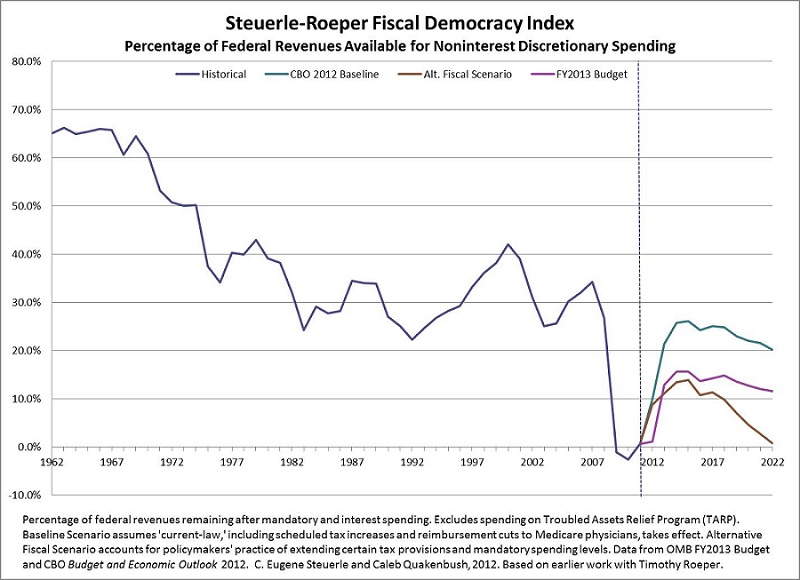Fiscal Democracy Index: An Update
Posted: May 4, 2012 Filed under: Shorts, Taxes and Budget 6 Comments »This chart provides an update on percent of federal revenue available for discretionary spending over time.
Eugene Steuerle and his colleague, Tim Roeper, have developed a “fiscal democracy index” to document the fall in the fiscal freedom of our policymakers in recent years and into the future. To calculate the index, Steuerle and Roeper measured the extent to which past and future projected revenues are already claimed by the permanent programs already in place (including interest payments on the debt). The fiscal democracy index is neutral politically, favoring neither a liberal or conservative agenda, in the sense that it falls with both rising commitments from the past and reduced revenues. It fell into negative territory for the first time in history in 2009 – meaning that revenues were already falling short of the built-in spending of permanent programs – and it will return to negative territory soon if Congress does not change current entitlement and tax policies. Even reducing annual non-entitlement spending to zero – thus, ending education, transportation, housing, defense, and most other general government programs – will do little to alter the downward path of the index other than reduce some interest costs temporarily. That means that future generations will have no additional revenues to finance their own new priorities, and they will actually have to raise new revenues or cut other spending just to finance the expected growth in existing programs.
Fiscal democracy will be a central concept of Gene’s forthcoming book with Larry Haas.



[…] we’ve gone long past the point where our federal budget could be flexible. A fiscal democracy index I developed with Tim Roeper shows that the combination of entitlement growth and low revenues means […]
[…] we’ve gone long past the point where our federal budget could be flexible. Afiscal democracy index I developed with Tim Roeper shows that the combination of entitlement growth and low revenues […]
[…] expected revenues. To illustrate this dynamic, Steuerle and Tim Roeper have constructed a “Fiscal Democracy Index.” It measures the extent to which future revenues have already been claimed by permanent programs […]
[…] Steuerle-Roeper Fiscal Democracy Index measures how much of the allocation of government revenue is determined by current democratic […]
[…] Steuerle-Roeper Index of Fiscal Democracy measures the amount of tax dollars remaining after payments on permanent programs and interest […]
[…] 20 percent remain. In a decade, that number will approach zero. Eugene Steuerle’s index shows that “future generations will have no additional revenues to finance their own new priorities, and […]